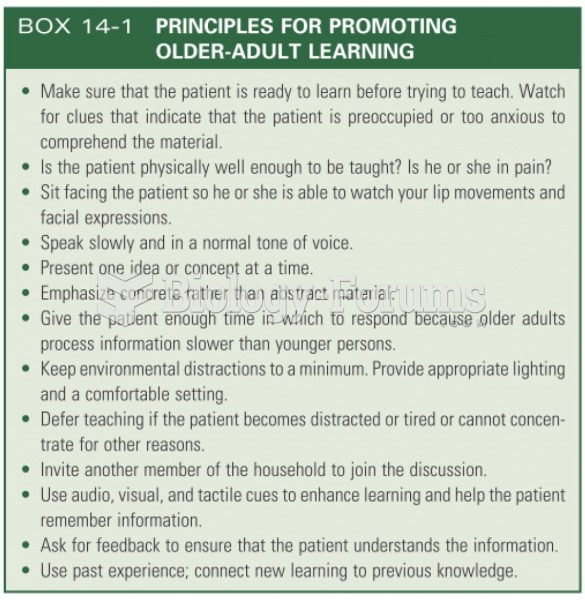Answer to Question 1
D
Hispanic men are less likely to report pain because their culture tells them to deny and withstand pain without complaining. The nurse uses the FPS-R to validate the patient's report because the postoperative period in knee replacement surgery is very painful; this fact makes the nurse think that the patient is likely to have pain. The HIGN has data that support the claim that Hispanic and African-American older adults prefer using the FPS-R for evaluating pain. The Numeric Rating Scale, the Verbal Descriptor Scale, and the Iowa Pain Thermometer are valid and reliable assessment tools, but older Hispanic adults prefer using the FPS-R.
Answer to Question 2
A, B, D, F
a. Correct. An older adult with myasthenia gravis has a chronic, progressive disorder charac-terized by muscle weakness, especially after exercise. Crises can develop as a myasthenic crisis, characterized by severe, generalized, muscle weakness with life-threatening conse-quences, or a cholinergic crisis, generally caused by an excessive dose of medication and characterized by excessive salivation and lacrimation, tachycardia, and diarrhea. The nurse recognizes the cognitive function to manage his finances successfully as a potential for self-care of his condition and can use this potential ability to plan care in the disability as-sessment.
b. Correct. Living in an adult community implies independent living and some ability to perform self-care activities.
c. Incorrect. Walking around the house is not an asset for this man because individuals who have extrapyramidal symptoms from antipsychotic medication can walk around the house. Walking around the house is probably more indicative of limitations from myasthenia gra-vis; however, it does not indicate a resource need.
d. Correct. To have Medicare health coverage there must be a need for skilled nursing ser-vices in the home; thus, if the patient requires assistance with activities of daily living, he must depend on his wife or another resource.
e. Incorrect. History of peptic ulcer disease is a neutral aspect of this man's disability as-sessment.
f. Correct. Living with another adult can be an asset. For this man, his wife identifies an area of a needed self-care resource because, although she can be trained to identify deteriorat-ing muscle strength in this man, her ability to manage a crisis effectively is impaired with poor eyesight. Thus, the nurse uses the gap between his cognitive function and the wife's ability to manage a crisis to plan nursing care.






